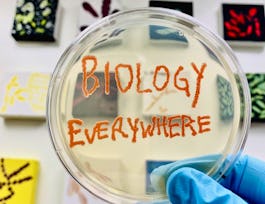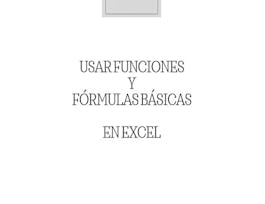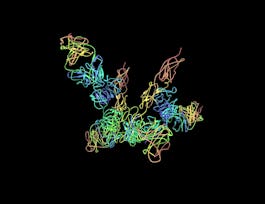Large-scale biology projects such as the sequencing of the human genome and gene expression surveys using RNA-seq, microarrays and other technologies have created a wealth of data for biologists. However, the challenge facing scientists is analyzing and even accessing these data to extract useful information pertaining to the system being studied. This course focuses on employing existing bioinformatic resources – mainly web-based programs and databases – to access the wealth of data to answer questions relevant to the average biologist, and is highly hands-on.



Bioinformatic Methods II
This course is part of Plant Bioinformatic Methods Specialization

Instructor: Nicholas James Provart
Sponsored by InternMart, Inc
35,688 already enrolled
(483 reviews)
Skills you'll gain
Details to know

Add to your LinkedIn profile
9 assignments
See how employees at top companies are mastering in-demand skills

Build your subject-matter expertise
- Learn new concepts from industry experts
- Gain a foundational understanding of a subject or tool
- Develop job-relevant skills with hands-on projects
- Earn a shareable career certificate


Earn a career certificate
Add this credential to your LinkedIn profile, resume, or CV
Share it on social media and in your performance review

There are 8 modules in this course
In this module we'll be exploring conserved regions within protein families. Such regions can help us understand the biology of a sequence, in that they are likely important for biological function, and also be used to help ascribe function to sequences where we can't identify any homologs in the databases. There are various ways of describing the conserved regions from simple regular expressions to profiles to profile hidden Markov models (HMMs).
What's included
4 videos4 readings1 assignment
In this module we'll be exploring protein-protein interactions (PPIs). Protein-protein interactions are important as proteins don't act in isolation, and often an examination of the interaction partners (determined in an unbiased, perhaps high throughput way) of a given protein can tell us a lot about its biology. We'll talk about some different methods used to determine PPIs and go over their strengths and weaknesses. In the lab we'll use 3 different tools and two different databases to examine interaction partners of BRCA2, a protein that we examined in last module's lab. Finally, we'll touch on a "foundational" concept, Gene Ontology (GO) term enrichment analysis, to help us understand in an overview way the proteins interacting with our example.
What's included
4 videos2 readings1 assignment
The determination of a protein's tertiary structure in three dimensions can tell us a lot about the biology of that protein. In this module's mini-lecture, we'll talk about some different methods used to determine a protein's tertiary structure and cover the main database for protein structure data, the PDB. In the lab we'll explore the PDB and an online tool for searching for structural (as opposed to sequence) similarity, VAST. We'll then use a nice piece of stand-alone software, PyMOL, to explore several protein structures in more detail.
What's included
4 videos2 readings1 assignment
What's included
1 assignment
When and where genes are expressed (active) in tissues or cells is one of the main determinants of what makes that tissue or cell the way it is, both in terms of morphology and in terms of response to external stimuli. Several different methods exist for generating gene expression levels for all of the genes in the genome in tissues or even at cell-type-specific resolution. In this class we'll be processing and then examining some gene expression data generated using RNA-seq. We'll explore one of the main databases for RNA-seq expression data, the Sequence Read Archive (SRA), and then use an open-source suite of programs in R called BioConductor to process the raw reads from 4 RNA-seq data sets, to summarize their expression levels, to select significantly differentially expressed genes, and finally to visualize these as a heat map.
What's included
4 videos2 readings1 assignment
When and where genes are expressed (active) in tissues or cells is one of the main determinants of what makes that tissue or cell the way it is, both in terms of morphology and in terms of response to external stimuli. Several different methods exist for generating gene expression levels for all of the genes in the genome in tissues or even at cell-type-specific resolution. In this class we'll be hierarchically clustering our significantly differentially expressed genes from last time using BioConductor and the built-in function of an online tool, called Expression Browser. Then we'll be using another online tool that uses a similarity metric, the Pearson correlation coefficient, to identify genes responding in a similar manner to our gene of interest, in this case AP3. We'll use a second tool, ATTED-II to corroborate our gene list. We'll also be exploring some online databases of gene expression and an online tool for doing a Gene Ontology enrichment analysis.
What's included
4 videos2 readings1 assignment
When and where genes are expressed in tissues or cells is one of the main determinants of what makes that tissue or cell the way it is, both in terms of morphology and in terms of response to external stimuli. Gene expression is controlled in part by the presence of short sequences in the promoters (and other parts) of genes, called cis-elements, which permit transcription factors and other regulatory proteins to bind to direct the patterns of expression in certain tissues or cells or in response to environmental stimuli: We'll explore a couple of sets of promoters of genes that are coexpressed with AP3 from Arabidopsis, and with INSULIN from human, for the presence of known cis-elements, and we'll also try to predict some new ones using a couple of different methods.
What's included
4 videos2 readings1 assignment
What's included
1 reading2 assignments
Instructor

Offered by
Why people choose Coursera for their career




Learner reviews
483 reviews
- 5 stars
77.63%
- 4 stars
20.28%
- 3 stars
1.44%
- 2 stars
0.62%
- 1 star
0%
Showing 3 of 483
Reviewed on Aug 23, 2015
Excellent course with excellent support by the Professor and Mentor. Covers what you need to know about protein bioinformatics and detailed expression analysis.
Reviewed on Jun 7, 2020
very informative course and it is very well explained
Reviewed on Sep 7, 2015
I was a very very useful course, specially the heatmap plot generation and R language lab exercises was great!
Recommended if you're interested in Health

University of Colorado Boulder

Rice University

Coursera Project Network

University of California San Diego

Open new doors with Coursera Plus
Unlimited access to 10,000+ world-class courses, hands-on projects, and job-ready certificate programs - all included in your subscription
Advance your career with an online degree
Earn a degree from world-class universities - 100% online
Join over 3,400 global companies that choose Coursera for Business
Upskill your employees to excel in the digital economy


